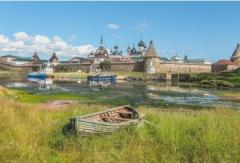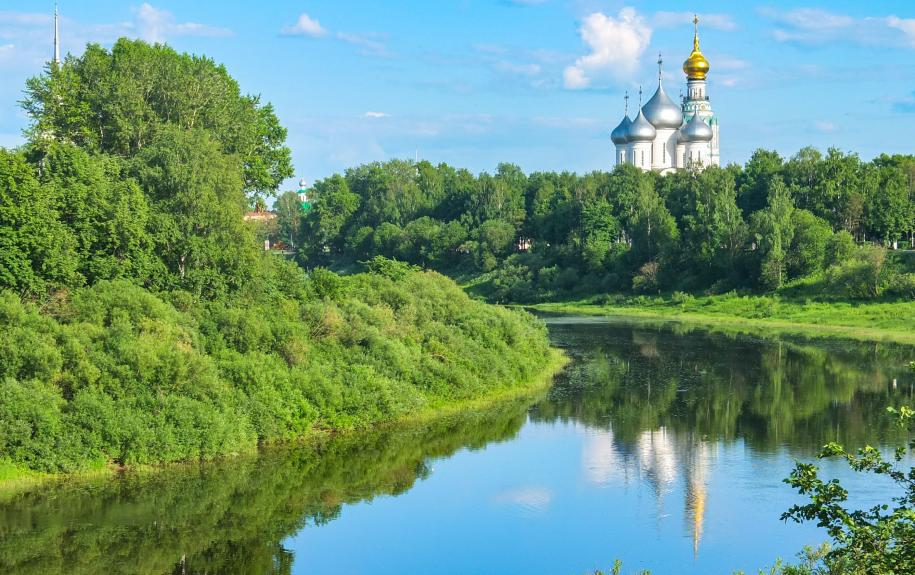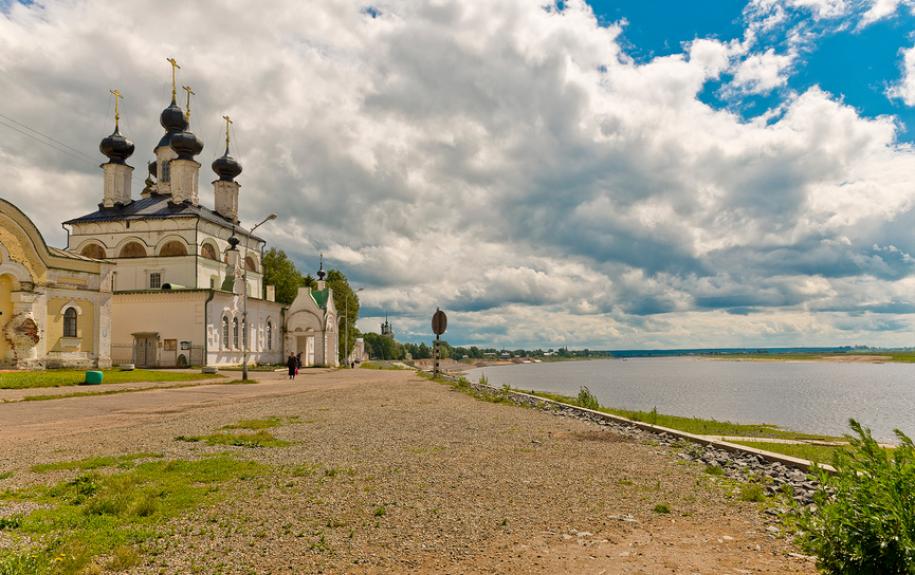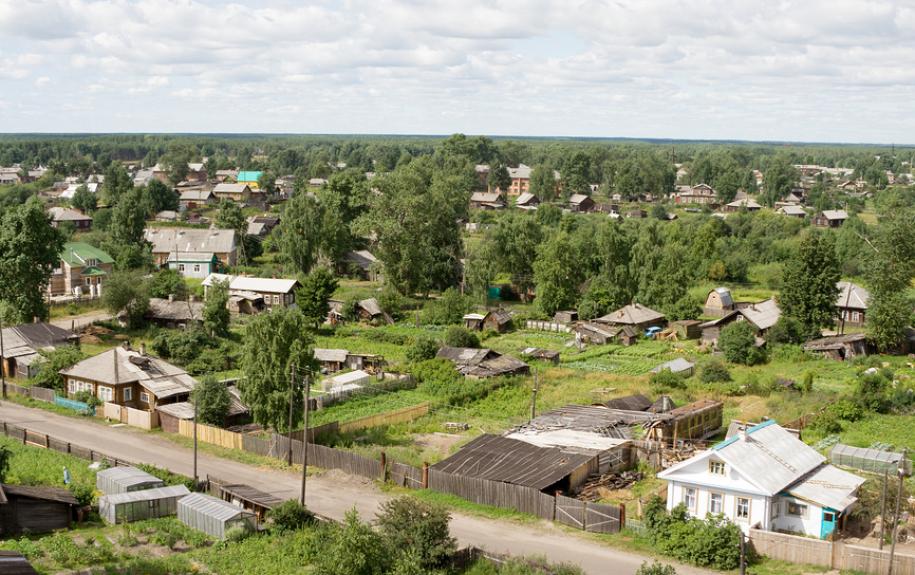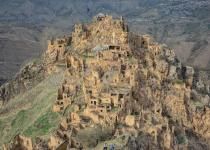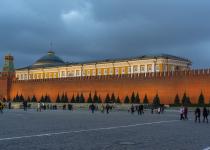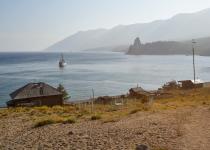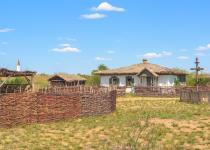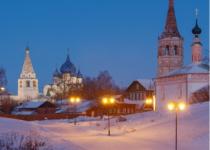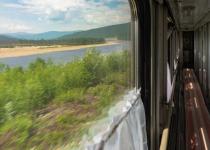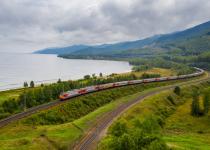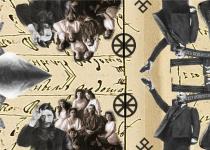On this trip, you will travel to a beautiful corner of Russia - the Vologda and Arkhangelsk regions of the Russian North.
Vologda - this is one of the most well-preserved old cities in Russia. A large number of wonderful architectural ensembles can still be found in the historical centre of the city, including St Sophia’s Cathedral which still has its amazing original frescoes. Vologda is famous for its wooden architecture and many people come here just to see the wooden houses with their elaborately carved window frames. You will also visit a museum of wooden architecture in the village of Semenkovo. Many wooden masterpieces have been brought here for preservation from all over the Vologda Region.
Veliky Ustyug - another old city in the Russian North, which has a historical centre boasting over 29 churches dating from the 17th and 18th centuries and dozens of architectural monuments from the 19th century. It is also famous for being home to Dyed Moroz (Grandfather Frost) - the Russian equivalent of Father Christmas. Since being named as his residence, the city gained all the infrastructure needed for such an important person and for all the children who come to visit him each winter.
Kirillo-Belozersky Monastery and Ferapontov Monastery - the Kirillo-Belozersky Monastery is located on the shores of Siversky Lake and is one of the largest monasteries in the whole of Russia, while the nearby Ferapontov Monastery is protected as a UNESCO World Heritage Site thanks to its frescoes painted by famous icon-painter Andrey Rublev.
Totma - this city has its own architectural style known as Totma Baroque and you can see it employed in its cathedrals and churches. These buildings resemble in form ships, representing the city’s links with river and ocean trade and exploration.
Solvychegodsk - an excellent example of a typical historical city of the Russian North, which has preserved the slow temp of provincial life. It is located off most tourist routes as it is a bit out of the way in terms of transport links. The city was a site of exile during the Tsarist era and Stalin spent some time here. The museum where he was housed has since been turned into a museum.
1 DAY / TRAIN TO VOLOGDA

Evening transfer from your hotel to the railway station.
Overnight train to Vologda.
2 DAY / VOLOGDA

Morning arrival in Vologda. Transfer to the hotel.
City Tour of Vologda - the old and especially beautiful Russian city was founded in 1147, the same year as Moscow. Highlights include:
-
Lace Museum - Lacemaking is an old trade in Vologda, and the city is famous for it. The lace is highly prized for its delicate patterns standing out against the background lace. This allows all sorts of images to be created and some of them will shock you with their size and complexity.
-
Vologda Kremlin - although the Kremlin walls no longer stand, the term Kremlin is still used for the very core of the city’s historical centre. The original 16th and century kremlin churches and chambers have been preserved and it was here that Ivan the Terrible once planned to set up residence.
-
St Sophia’s Cathedral - this 16th-century structure is the oldest building in the city. It was built on the orders of Ivan the Terrible and contains a five-storey carved and gilded iconostasis.
-
Zasetsky House - this old wooden house was once owned by an important Vologda noble family. It is the oldest wooden house in the whole city.
-
Spaso-Prilutsky Monastery - this is one of the oldest Orthodox architectural complexes in Russia. It was founded by St Dmitry of Priluki, a pupil of St Segius of Radonezh. Most of its buildings date from the 16th and 17th centuries, including the Saviour Cathedral, the Ascension Gate-Church and the Presentation of Virgin Mary Church, as well as the 16th-century chambers. The Dormition Church here dates from 1519 and is the oldest surviving tent-dome church in Russia.
3 DAY / KIRILLOV

A day outside Vologda.
Semenkovo - this is one of the best open-air archaeological and ethnographic museums in Russia. Many wooden buildings dating from the 19th and early 20th century were brought here for preservation from various parts of the Vologda Region. Traditional northern houses are like wooden fortresses and combine living quarters with working areas. The oldest building here is the Kochkin House, which was built in the 1870s.
Kirillo-Belozersky Monastery - this very old and large monastery is located on the shore of Lake Siversky. Ivan the Terrible visited several times and made generous donations to it. It was also used as a place of exile for Russian nobles. From the tall thick walls of the monastery, you get great views of the neighbouring lake and forests.
Ferapontov Belozersky Monastery - this monastery includes the Museum of Frescoes by Dionisius, which offers an excursion around the monastery including a visit to St Martinian’s Church and the Nativity of the Virgin Mary Cathedral with its frescoes dating from 1502 and painted by the renowned icon painter Dionisius. These frescoes are protected by UNESCO.
Lunch.
Return to Vologda.
Night in Vologda.
4 DAY / TOTMA

Transfer to Totma. Distance: 210km
Tour of Totma - this old city is like no other in terms of architecture, and its unique style has become its calling card. Its exquisite baroque churches are somewhat reminiscent of ships in their form commemorating the fact that in the 18th century the city was a centre for seafarers. Totma merchants equipped 20 expeditions to the Pacific Ocean, more than merchants from Moscow and Vologda combined. In 1812, on one of these expeditions, Ivan Kuskov sailed to California and founded a fortress there which is now known as Fort Ross.
Lunch.
Dinner.
Night in Totma.
5 DAY / OPOKI

Transfer to Veliky Ustyug. Distance: 240km
Opoki - on the way to Veliky Ustyug you will see an interesting natural phenomenon - a cliff face exposing rock strata that formed at a bend of the River Sukhona over 200 million years. It has almost equal layers of pale pink, dark grey, dark brown, light brown and pink consisting of clay, marl, limestone and siltstone.
Boat trip on the River Sukhona.
Lunch.
Transfer to your hotel in Veliky Ustyug.
Dinner.
Night in Veliky Ustyug.
6 DAY / VELIKY USTYUG

City Tour of Veliky Ustyug - today Veliky Ustyug is most famous among Russians as being the official residence of Grandfather Frost (the Russian Father Christmas). However, even without this link, the city is worth visiting thanks to its multitude of historical buildings. The city is often called an open-air museum and a northern equivalent of Suzdal. Highlights of the tour include:
-
Cathedral Complex - this central complex of cathedrals get its name for being the site of three cathedrals: the Dormition Cathedral, St Procopius of Ustyug’s Cathedral and St John of Ustyug’s Cathedral. From the bell tower of the Dormition Cathedral, you can enjoy great views of the city centre and the neighbouring Dymovskaya Sloboda. The 17th century Dormition Cathedral also has its original frescoes and a seven-tier iconostasis.
-
Estate House of the Merchant Usov - this two-story mansion with an inclining roof now houses a museum of local history. Some of its exhibits are over a thousand years old and include household items, weapons and examples of a famous local artform: carved and decorated bark.
-
Grandfather Frost’s Residence - this is a land of Russian fairy tales, with a magical terem building and a wonderful forest.
Visit the Village of Kuznetsovo - this is a quintessential Russian village and here you can immerse yourselves in rural traditions: relaxing in a banya, getting water from a well, taking part in haymaking, woodcutting, and collecting herbs, berries and mushrooms. Your reward will be an aromatice cabbage soup (shchi) and a tasty pie cooked in a Russian oven.
Excursion of a Northern Chern Factory - northern chern (derived from the Russian word for ‘black’) is an art form involving engraved silver decorated with a black mixture made from various metals. This process is known as niello in the West, from the Latin word for ‘black’. The exact mix of components is a secret of the trade. This art form has been produced in Veliky Ustyug since the 10th century and the city gained a reputation for it back in the 16th century. On this excursion around the northern chern factory, you will learn about the art and even try your hand at applying the black mixture to a silver coin.
Dinner.
Night in Veliky Ustyug.
7 DAY / SOLVYCHEGODSK

Transfer to Solvychegodsk.
City Tour of Solvychegodsk - on this day you will set off to a remote city located in the northern forests - Solvychegodsk, which is one of the oldest Russian cities in the Russian North. In the 16th and 17th centuries, thanks to the salt trade, it was the largest and most important city of the North and up until the end of the 17th century, it was the starting point of the trade route to the Urals and further to Siberia from European Russia, which of course enabled the city to grow rich. However over time, the salt reserves began to diminish and a new, more southerly, the route was opened to Siberia, while Arkhangelsk, a new northern city on the coast, grew in importance. This all led to the decline of Solvychegodsk, although thankfully architectural monuments from its golden age remain to this day. Highlights of this tour include:
-
Annunciation Cathedral - the architectural highlight of the city and one of the oldest stone cathedrals in the Russian North.
-
Stalin Museum - in later years Solvychegodsk found itself used as a place of exile for political prisoners fighting against the tsarist regime. The most famous exile was none other than Stalin and therefore Solvychegodsk is home to one of only four Stalin museums in Russia.
Lunch.
Dinner.
Return to Veliky Ustyug.
8 DAY / DEPARTURE

Transfer to the railway station of Kotlas.
Train to Moscow or St Petersburg.

- The tour is available the whole year round starting on any day, but please take into account that the museum’s working hours and days-off vary so we reserve the right to change the itinerary while trying to save the excursion programme.
- Optional excursions should be booked before the start of the tour to schedule the itinerary.
- Tickets to museums cannot be sold without an excursion with a guide.
- In cities along with the route where there are no 4-star hotels, the calculation includes hotels of 3 stars accommodation in higher category rooms.
- All excursions/guided tours included in the itinerary are private which means private guides and private transport along the programme - unless otherwise stated.
- Best time to travel on this route: from the end of April to mid-October and from December to mid-March.
• CANCELLATION POLICY •
DATE OF CANCELLATION |
CANCELLATION CHARGES |
|---|---|
| FROM 60 TO 45 DAYS BEFORE THE DEPARTURE | 10% |
| FROM 44 TO 15 DAYS BEFORE THE DEPARTURE | 30% |
| FROM 14 TO 7 DAYS BEFORE THE DEPARTURE | 50% |
| LESS THAN 7 DAYS BEFORE THE DEPARTURE | 100% |


